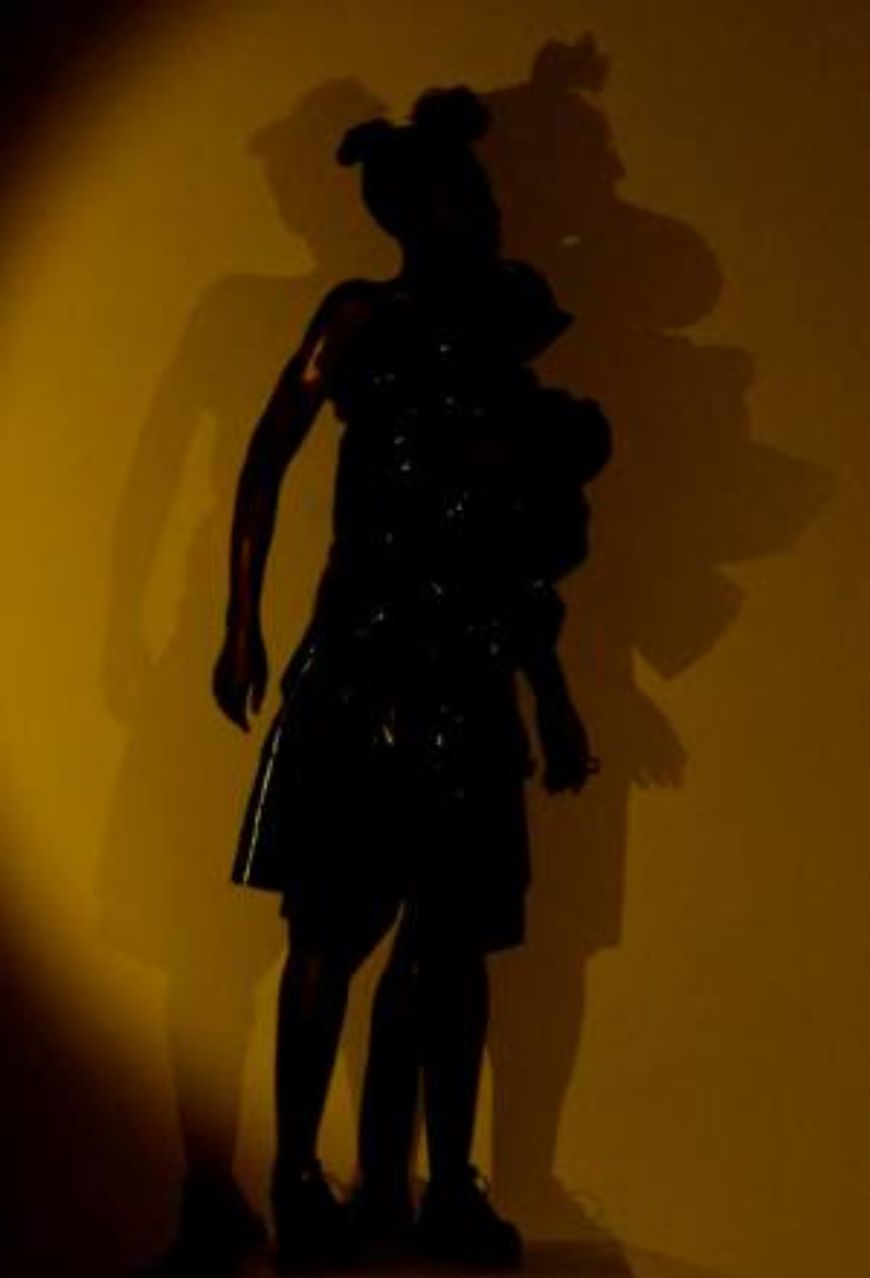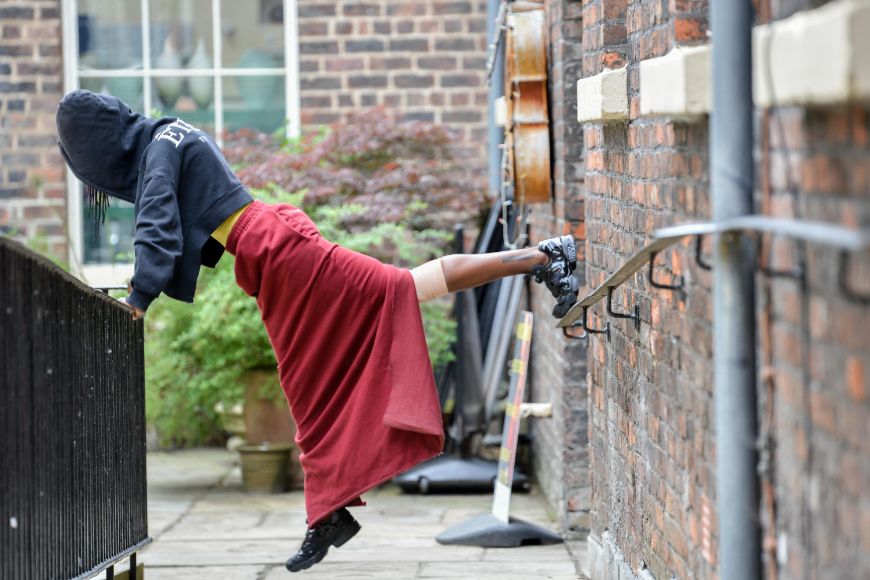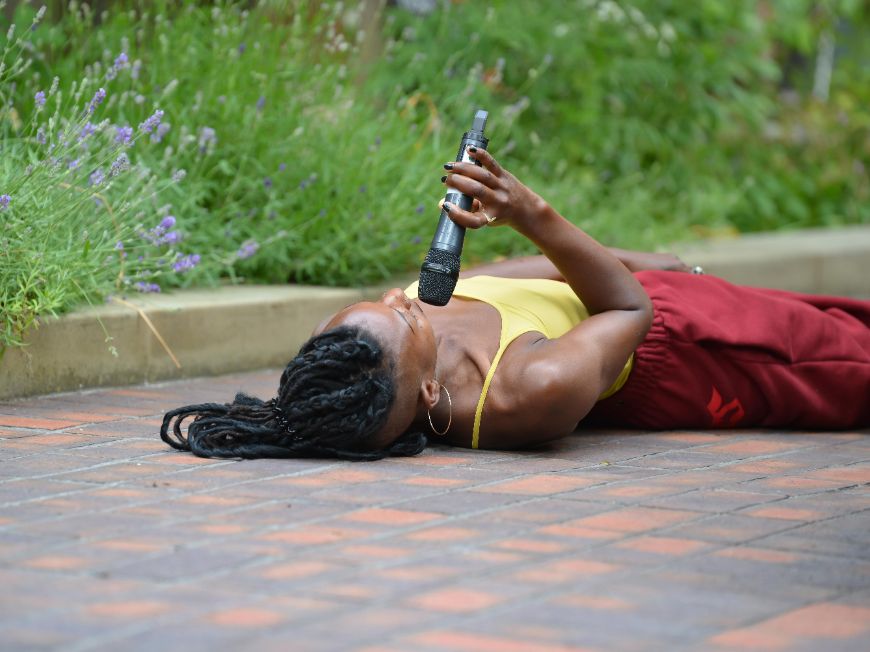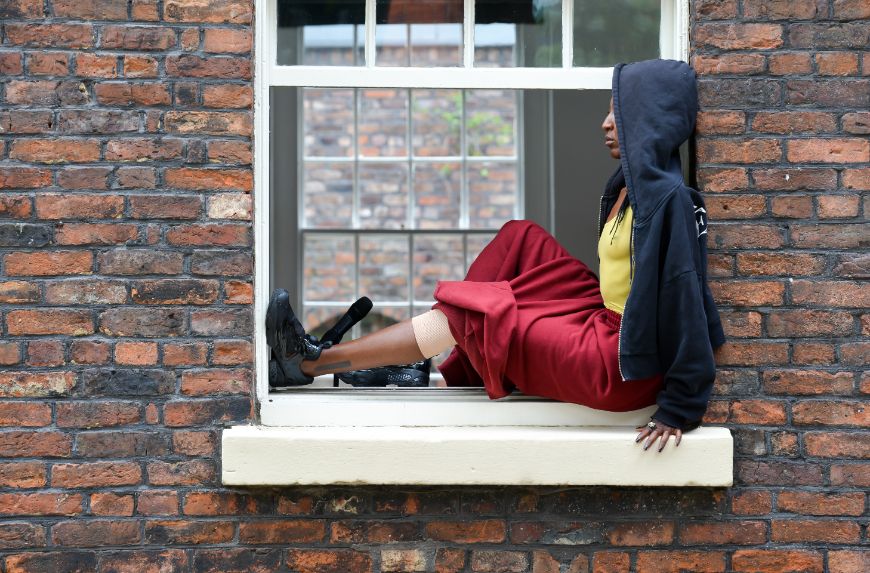Text | Interview | Gropius Bau 2022
“How Does This Place Speak?”
Interview with SERAFINE1369

As In House: Artist in Residence at the Gropius Bau in 2021, the artist and dancer SERAFINE1369 will engage with questions of intimacy, technology, alienation and boundaries through a practice of performance, dance, writing and choreography. In the following conversation, SERAFINE1369 talks about their experiences of working with ephemeral material, explaining how the body’s porosity can open it up to the oracular, guiding and unfolding the relation we have to ourselves and to one another.

SERAFINE1369 © Jamila Johnson-Small, photo: Ayka Lux
Sonja Borstner: You’ve described your works as “site-responsive” in a conversation with Fernanda Muñoz-Newsome about performance practices. In November 2021, you will share When we speak I feel myself, Opening, a duo-performance developed in collaboration with Muñoz-Newsome at the Gropius Bau. How will this collaboration respond to the Gropius Bau’s specific architecture and your residency titled visions?
SERAFINE1369: I’m in this tension as I prepare the work, asking: “What is here already? What does this space bring? How does this space speak – to me, to others?” And also: “What does it take for me to be able to be here: to appear and to allow myself to be witnessed?”
The Gropius Bau is not built for performance, in a way: to dance for a long time on the floors as they are would challenge my/our joints and potentially cause injury; the acoustics of the room we will present in are not prepared for either amplified sound or conversation, but silence, I suspect. So, this question of responsiveness becomes a question about how to move towards something without losing or denying oneself; one’s needs and interests: how can the work meet the space – as an opening, an outlet – without the space dominating and totally transforming the work?
The responsiveness is also in being attentive to the ways in which the things I am bringing resonate in the space, dialogue with the context (or not). Someone told me last year that there is no listening without consequence, and I think that this is where the “responsiveness” manifests: through attempts to listen to both inside and (with) outside. I don’t come with an idea that I want to impose on the space, but I think of the space, go to the room, and see what wants to come up – “visions” that emerge between the architecture, budget, logistical constraints, museum infrastructure, timeline, the desires of my body, and what is triggered or conjured in my imaginary.
Sonja Borstner: As a performer, how did the lockdown and isolation change your relation to space?
SERAFINE1369: I suppose there’s been more of a zooming in, into the micro. I was already busy with micro-movement: the impact of one shift in the room on everything else in the space; the passage of time (or I should say the presence of time or situation[s] of time) which leads to thinking about vibration as the source, as light, as movement and as sound. But I was also reflecting about our bodies as mechanisms formed through the happening and receiving of vibrations, systems of subtle and epic influence and communication that all substances and beings on the planet share. I went into these things in a more focused way. Without the constant energetic presence of so many others, I let myself feel more; felt myself in more detail, which shifts my experience of being in, and my understanding of, space.
Sonja Borstner: Your works – ranging from performance, dance and choreography – embody a sort of hybrid on the cutting edge between those categories. What are the challenges of working in media often seen as ephemeral?
SERAFINE1369: I think the ephemeral is no less material – it’s a fantasy that these things have no physical manifestation or lasting repercussion. This is part of what can make working with invisible things – or things that seem to appear and then disappear – a challenge. In conversation with an institution or a curator, as soon as I receive an email saying, “Would you like to do…”, I am already making tiny reorganisations inside myself to think about what to allow in that proposition. To think about what I might do, what I could do, if there’s space, and how I want to relate to that context. It’s a very minute internal adjustment or reorientation towards the idea of a work. From that point on, I feel I’m working, but that labour doesn’t get recognised as work. However, it’s very much part of my process of making anything, because I’m always tapping into an ongoing set of practices or things. Performing is an energetic labour and it involves energetic opening of the self. To be in a state of readiness to present a work, I have to open myself, and entering that tenderness is part of the work; the job.
Another challenge presenting this kind of work is, before performances, there can be this energetic spilling of anxiety from other people when I’m in this state of openness. In these moments, the labour of the work becomes about not distinguishing between what is mine and what is someone else’s, but about functioning as a channel of some kind: trying to work consciously with my energetic field, but not necessarily focused on creating boundaries, defences or protection. After performing in this way, I am sometimes very tired for a while. I don’t think it’s necessarily bad, but the aftermath that follows performing is not often discussed or compensated.
I feel that one of the challenges also becomes something that I try to, in different ways, attend to – both in terms of how I hold myself in conversations and in relation to the anxiety and energetic spilling that can happen pre- and post-performance. I am also trying to be as involved as I can – in conversations and infrastructures – to support the implementation of professional care, acknowledging these corporeal impacts of “ephemeral” practices and to find language around them. The process of navigating boundaries and their politics is something that surrounds the ephemeral that I’m interested in.
I am trying to understand what it means to hold so much information, and I am very interested in varying systems of reading that information. Dancing can be one of those technologies of reading into it, but the language – or the non-language – of the reading is not simply translatable into verbal language.
— SERAFINE1369, 2021

SERAFINE1369, III (Something Flat, Something Cosmic, Something Endless), 2021. Commissioned by Liverpool Biennal © Jamila Johnson-Small, photo: Katarzyna Perlak
Sonja Borstner: You spoke of an “opening” while performing. I’m wondering, how do you relate to the audience and your own body in these states of openness?
SERAFINE1369: I am working to suspend judgment: the reading of physical coding and signs via other bodies and my own body and peoples’ physical ways of being. I try to turn off the filter with those parameters that can usually help us navigate daily life or protect us; inform us how to move and how to be proximate to different people; explain to us what the context is. Rather than thinking about my body, or about me as a set of social codes, or as something that conveys meaning or communicates through coded gestures that function on a social plane, I am trying to connect on an energetic level with what in the room can be physical and sensorial. I ask myself how I can shape the space so that people present are able to be supported while also connecting to their own physical sensations and emotional experience – the memories, thoughts or feelings that are flowing through them.
Sonja Borstner: Bodies can be considered as an archive, carrying echoes of individual, collective and historical knowledge and experiences. You extend this idea, viewing the body as oracle, speaking of “oracular practice” as guiding your works’ unfolding. Can you explain how this particular concept shapes your working processes?
SERAFINE1369: Our bodies are impacted by the entirety of our experience without our choosing; it’s just happening. In our conscious thinking there’s a more personally constructed reality, but I think bodies are taking everything in. I am trying to understand what it means to hold so much information, and I am very interested in varying systems of reading that information. Dancing can be one of those technologies of reading into it, but the language – or the non-language – of the reading is not simply translatable into verbal language.
I think we live within these incredible resources that can teach us so many things, but at the same time, they’re also us, right? So, this relationship between that core tension of the proximity and distance I have with myself, I think about while using dance as this kind of miraculous technology. Working with oracular practice, I am trying to protect the space from both my own criticism and external factors. It might be that I don’t know what I will do, or how I will resolve a certain aspect of a work, or why a certain gesture or object is important until the day before the show; it might be that I don’t know until after the show, but I am giving permission or space to not even knowing what the known might look like.
Sonja Borstner: Rethinking the way we set, measure or imagine time appears too at the core of your practice, which you describe as “flowing with the nonlinearity of time”. Can you explain what time means to you and how it informs your works?
SERAFINE1369: There are many different ways of tracking or marking time. In my work, there’s a desire to be with more than Greenwich Mean Time – the time that somehow has been claimed as a singularity, as a truth, as the one register. Thinking about what that produces in me as a person, as a body and socially, is what interests me – creating spaces where the messiness of time can also be a reality without question.
And to go back to your previous question about the challenges of ephemeral work: ephemeral encounters as such are, in a way, unknowable. When they happen over one hour on a certain day in one of my performances, I don’t know when or how that show lands in someone, or in me, because this occurs on a different timeline and constellation of relations. Seeing or witnessing ourselves in relation can be a useful device, because colonial time – Greenwich Mean Time, clock time – is manifest and successful through the servicing of the slave trade, and this dialogue and movement is enabled across continents, a movement of colonialism and imperialism.
“What does it mean to me to be held by the temporal structures that have stripped, and continue to strip, my body and the bodies of my ancestors of agency? And what does it mean to choose, as much as there is a choice? When is a 24-hour structure a container, and when and how does that container become violent? How does that structure counter the times of my body cycles – I say “me” because it’s specific, but I don’t only mean me – when they don’t align with the times of the 24-hour clock?” These are questions I ask myself. At the moment, I am curious about the unit of one minute, and how a minute can feel completely different: a minute can feel like forever, it can feel like a second, it can be incredibly expansive, and it can be gone. I am using this unit of a minute to try to learn more about my physical and embodied relationship to time, to being in relation through this technology rather than being run by it.
I am using this unit of a minute to try to learn more about my physical and embodied relationship to time, to being in relation through this technology rather than being run by it.
— SERAFINE1369, 2021
Sonja Borstner: One of your recent works, I I I (something flat, something cosmic, something endless) (2021) uses the unit of one minute as a way of “considering the invention of colonial time and agency and the ways we inhabit its units of fixed endless measurement.” Can you explain how the reconsideration of time is embedded in this particular performance?
SERAFINE1369: I I I (something flat, something cosmic, something endless) is a durational performance over six hours. With Josh Anio Grigg, the sound designer, we made a 24-hour speaking clock using my voice, announcing each minute. I’m asking: “What can that structure produce that is generative? Can I find a sense of being free of time through being in relation to every minute? Will it be oppressive as an experience for all of us there, or will it enable us to abandon the constraints of time?” I don’t know. It’s this tension between structure and chaos – maybe like an organising principle – and a sensory overload. Navigating this edge between control and abandon and how to have self-sovereignty in relation to structures that hold or constrict, frame or decide things for us about bodies in relation, is what interests me.
We are also in a quite crucial moment where a choice is made about whether “clock time” stays in sync with celestial time, solar time, or not, as the planets move and the relationships between them are incrementally transforming. I’m curious about what that does – if time, then, is completely owned by capitalism. I wonder if there’s something that happens to us in our detachment from celestial bodies, existing only within that historical or imagined relation with the environment.

SERAFINE1369, III (Something Flat, Something Cosmic, Something Endless), 2021. Commissioned by Liverpool Biennal © Jamila Johnson-Small, photo: Katarzyna Perlak
Sonja Borstner: Since the beginning of the pandemic, many people have been experiencing vivid and unusual dreams. In some of your works, it appears that you use dreams as resources. What interests you about these imagined worlds that are decoupled from linear temporalities and localities?
SERAFINE1369: Perhaps dreams have become more central because the accessible material has been less about moving in space and more about moving inwards. For many of us, dreams were, perhaps, the place where we could experience the most extensive movements during the past one and a half years.
I am also interested in dreaming as labour, both in terms of the labour of imagining work, things, desires, and in terms of the night-time. We’re alive; we never rest. I think “rest” is, in a way, a fantasy, because it is only a different state where we do other kinds of work: both the healing of our bodies from the impact of daily activities and processes, and the processing of psychic, energetic, emotional, relational information from the day or from our lives across time. I am perhaps slightly troubled that relaxation or rest is conventionally removed and considered distinct from the realm of labouring, because I think our bodies are labouring constantly and somehow, this is life.
I’m fascinated by what that labour produces. In a very visible way, we can take this as part of my interest in dancing, right? Like watching or experiencing the body working: working things out, working muscularly, doing its exercising, its releasing, its mechanisms like being in relation to the forces at play on them on this planet. I’m very curious about witnessing bodies move, and there’s so much more that comes through in even pedestrian movements of a body. This is the material that I work with, this is the stuff of dancing.
I’m also interested in how we hold or contain porousness, this porosity of outside things coming into the psyche of the subconscious at night – so many people, so many bodies, so many creatures. The fact that we refer to ourselves as singularities – is that really accurate? Myriads of bacteria and creatures form and enable us and then we go around, being like: “Oh, well, I think…”.
Sonja Borstner: In your essay Cycles and Fragmentary Returns (19/2020), you wrote “When I feel lost, I look to previous selves to guide and hold me”, or elsewhere you mention “I am already not singular.” Multiplicity appears to inform your practice on various levels – for instance, through different pseudonyms, in changing collaborations and within polyphonic media. The notion of being multiple stands in contrast to normative narratives of Western art history and the concept of the singular artist. Do you think this idea of the self as a collective entangled in multiple temporalities can overcome these oppressive historical structures?
SERAFINE1369: I’m so fascinated by bodies and so fascinated with the world, the environment, the cosmos. There are many interesting things that I’m learning, things that I hear about existence and the situation of being embodied, that counter the singular and binary narratives it is suggested that we live by; narratives which are often confusing, inefficient, ineffective, dysfunctional.
In my work, I’m very interested in allowing the multiple to break through via the widening of a gaze; a permission for people to choose what they focus on. You don’t have to look at me while I’m performing: you can look inside your mind, you can look at the thing in the corner of the room, that fly, at your phone. It’s between these things that we emerge, through these multiplicities that we hold. I think the work wants to emerge through that entanglement, which also includes the multiplicities of the people present, watching, being, witnessing.
Sonja Borstner: The curator and theorist iLiana Fokianaki argued for an understanding of care as collective and radical act in her two-part essay in the Gropius Bau Journal. Do concepts of collective care resonate with your works?
SERAFINE1369: I am really wary of the trend of talking about care these days. I think a conversation about care is a conversation about accountability and structures, how we relate to one another and how we look after ourselves, and yet grow awareness of ourselves and our impact on the world. Returning to one of your first questions about the challenges of ephemeral work, or how I’m working with performance, there is also an ask for the other people professionally involved: to have a level of self-awareness and care for themselves in order to extend that, to me – to us – as performers. I’m trying to understand my boundaries and limitations; I’m trying to understand the conditions that the people I am working with, the audience and I need and how to create them. It can be a lifetime project.
I think a lot about how care relates to candour and rigour, asking myself questions like: “How can I open that up to others, others that I work with, others that are watching? How can I move through the world aligned as closely as possible with my ethics and with the things that I know?” “Oracular practice” in that sense, is also contending with the idea that anything can be a teacher; anything can be a guide, and it can become that through how we relate to it – if there is an openness and a listening. Those things, to me, speak to care, and I guess, to my dance practice: this attempt to listen and allow my body to do what it needs. Knowing what my body needs, when it needs it. But it’s not only about my body as an isolated thing, it’s about my body as a porous entity.

SERAFINE1369, III (Something Flat, Something Cosmic, Something Endless), 2021. Commissioned by Liverpool Biennale
SERAFINE1369, previously known as Last Yearz Interesting Negro (2016–2020), is the artist and dancer Jamila Johnson-Small. They work with dancing as a “philosophical undertaking,” as “a political project with ethical psycho-spiritual ramifications for being-in-the-world”, as they term it. Their work is informed by research into movement and dance as a tool for divination to be processed through the means of choreography. Recent projects have taken place at Liverpool Biennial (2021), Tai Kwun, Hong Kong (2021), CA2M, Madrid (2020), MDT, Stockholm (2020), Silencio, Paris (2019), Transmediale, Berlin (2019), Barbican, London (2019), Café Oto, London (2019), ICA, London (2018), Palais de Tokyo, Paris (2018), amongst others.
Sonja Borstner is a writer and assistant editor at Gropius Bau Journal.

SERAFINE1369, III (Something Flat, Something Cosmic, Something Endless), 2021. Commissioned by Liverpool Biennale